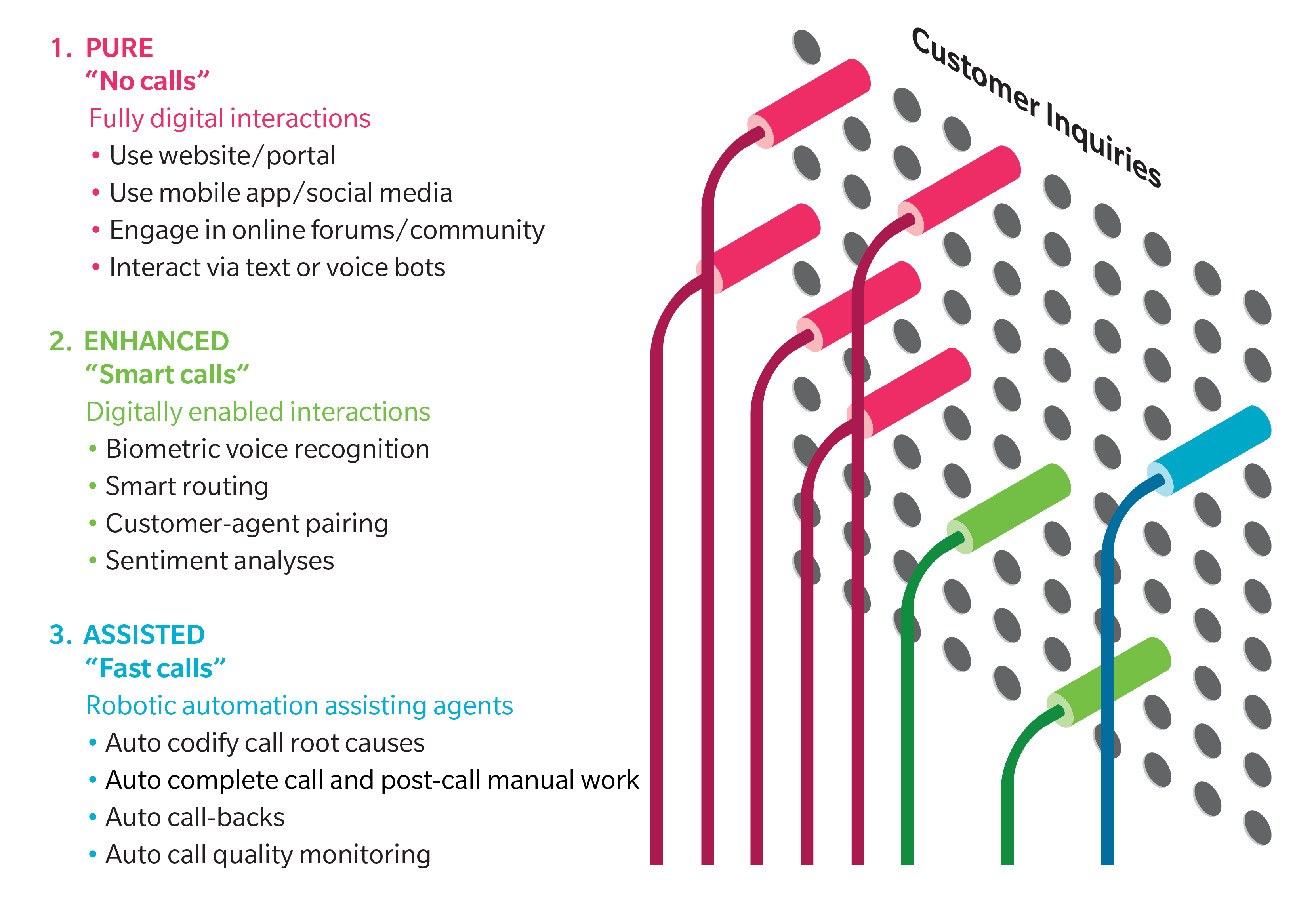Not long ago, customers were frustrated “talking” to automated-response systems, screaming responses into phones, and frantically pushing “0” to make contact with a human. Today, customers find it fairly reasonable to interact with voice assistants and automated bots such as Apple’s Siri and Amazon’s Alexa, which are increasingly hassle free, intuitive, and efficient.
The reason for this change is simple: Digital interaction technologies have evolved rapidly in the past decade; in-app and social media supported virtual assistants are available on-demand; biometric authentications offer device and access convenience; and advances in artificial intelligence (AI) and machine learning now enable these virtual assistants to be smarter, and more personalized and empathetic.
Contact-center executives need to determine the moments of truth where old-fashioned human contact are critical to maintain loyalty
However, actual adoption rates vary widely across products and segments. For example, consumers are more likely to use chat bots to buy movie tickets or order pizza than to buy health insurance or open a checking account. Consumer preferences and behaviors also vary by segment. On one end of the spectrum are older customers who are more likely to prefer talking to a human, despite the long hold times or the dull sales pitches they must endure once connected; on the other end are younger customers who are more likely to opt-in for quick self-service options, such as text-based or voice- based virtual assistants enabled within a mobile app or a social media platform. Between these two ends of the spectrum lie many consumer segments whose preferences vary based on service severity, privacy, and frequency.
Operations executives need a strategy to offer customer service along a digital continuum—without breaking the bank. As a first step, contact-center executives need to determine the moments of truth where old-fashioned human contact are critical to maintain loyalty. For example, if someone is calling about potential fraud or has an unusually complex technical problem, they should be immediately directed to an agent. Similarly, situations that offer companies the opportunity to enhance relationships with cross-sell or up-sell, call for human contact. But all other customers can be migrated to digital self-service.
Based on results to date, it appears likely that the vast majority of calls and customers can be serviced digitally. For example, one international telecom company has already reduced the number of calls handled by humans by about half in the last four years. Customer migration to self-service digital channels does not happen overnight, especially for large incumbents with large contact centers. Amtrak, for example, launched its “Julie” self-service chat bot in the early 2000s to provide basic schedule information in 1,000 cities; Amtrak has since extended digital assistance to most cities in the US. In addition, Amtrak has continually added more complex functions, such as credit-card handling and seat selection. Today, with more AI tools available to Amtrak agents, the railroad has automated approximately 25 percent of its calls end-to end. But it took the railroad a decade to build up this digital infrastructure.
Leading pioneers in digital customer-service find three types of digital interactions gaining traction in contact centers (see exhibit “Three Types of Digital Interaction Are Transforming Customer Service”):
- Pure digital: “no calls”
- Enhanced digital: “smart calls”
- Assisted digital: “fast calls”
Three Digital Interactions Are Transforming Customer Service

1. PURE DIGITAL INTERACTIONS: “No Calls”
Across industries, incumbent companies with a traditional contact-center delivery model are redesigning websites and mobile apps to be simple, human-centered, and engaging. The goal is to improve self-service adoption by making it easy for customers to look up information and answers; by delivering a consistent look and feel across all interactions; by providing intuitive self-serve tools and utilities; and by connecting customers with other customers using social media and collaboration forums.
No matter how engaging the website, or how intuitive the mobile apps, there will be situations when customers prefer “human-like” interactions. For simple “FAQs,” voice and text-based chat bots are enabling incumbent companies in consumer-facing industries, such as food, telecom, banking, health and travel, to reduce 30-50 percent of contacts. That typically means 98 percent of chat requests must be answered within two minutes.
2. ENHANCED DIGITAL INTERACTIONS: “Smart Calls”
Introducing new technology for customer identification, agent matching, and sentiment analyses to augment traditional contact-center model is also proving effective in optimizing service-delivery costs.
Biometric voice-recognition, for example, eliminates traditional step-by-step authentication requirements. Customers no longer need to give their mother’s maiden name, PIN, or password, allowing agents to save precious seconds. A leading investment-management company used biometric voice-recognition to upgrade interactions with its 60,000 clients globally. Two years after introducing the technology, 97 percent of clients, accounting for 65 percent of calls, were voice authenticated. Call times were cut by 15 percent, complaints regarding verification dropped by 90 percent, and 93 percent of users ranked the system at 9 out of 10.
AI and machine learning can simultaneously improve customer experience and agent productivity
Some companies have even begun pairing biometric voice-recognition with self-service options that allow customers to pick the channel they prefer— human agent via call back or direct transfer versus chat bot. Once preferences are known, the identified caller is automatically routed to the preferred channel. In addition, such options allow contact-center operations to improve service levels while optimizing agent capacity.
AI and machine learning can simultaneously improve customer experience and agent productivity. A system called “behavioral pairing” matches agents with customers, based on customer behavior identified by software. For instance, if the software detects a customer is in a hurry, she will be directed to a less chatty agent. By pairing customers with agents whose personality and behavioral profiles align, companies can reduce call time while improving customer satisfaction. A large U.S. based retail pharmacy, for example, used behavioral pairing to cut average call time by 14 percent.
A similar AI application is “sentiment analysis.” The technology detects behavioral and speech patterns in real-time, identifying customer mood based on word choice or tone. This allows agents to better communicate with customers and more quickly wrap up calls. By adopting this technology, a leading U.S. health insurer decreased call time by 15 percent and callbacks by 10 percent. In both cases, shorter call times and decreased callbacks cut costs and improved the customer experience.
Robotic Process Automation (RPA), after early success in improving cost efficiency of non-customer facing back-office processes, is finding its way into contact centers
3. ASSISTED DIGITAL INTERACTIONS: “Fast Calls”
Robotic Process Automation (RPA), after early success in improving cost efficiency of non-customer facing back-office processes, is finding its way into contact centers. In a typical case, agents capture relevant information during a call, triggering a series of rules-based, robot actions on the backend to transfer data, offer templates and margin tools, validate credit ratings, or pass data to legacy-provisioning systems. Agents can respond much more quickly to requests because they don’t have to transfer the call to other agents’ groups, or search different databases for information. Overall, companies report efficiency gains of more than 80 percent for individual process steps, at least 40 percent less post-call processing, and a 20 percent drop in call time.
CHOOSE YOUR MODEL: PURE DIGITAL TO FULLY HUMAN
Digitization has changed the face of customer service. It is now technologically possible for companies to respond to customers’ wishes or complaints with interactions that range from purely digital to completely human, with hybrid solutions in between. Companies approaching customer-service digitization with a singular intention of reducing call volumes are likely to be disappointed on both cost and customer-experience metrics. On the contrary, companies that are strategic about digitizing their contact centers are likely to lower the cost of serving customers, self-fund future investments in customer-service digitization, and enhance service delivery levels—while demonstrably improving both customer and agent experience.






